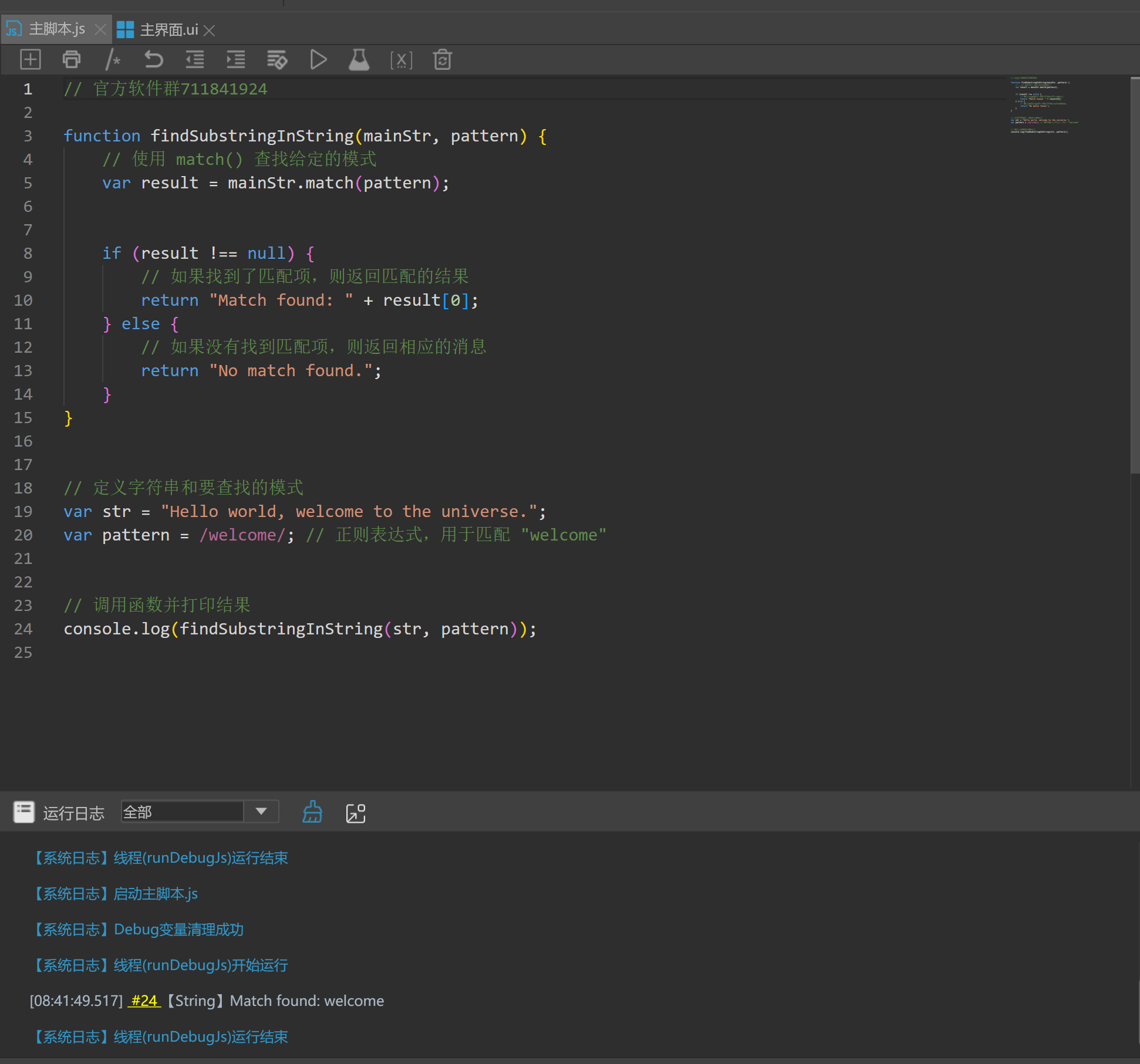AIWROK软件内容匹配 match()函数用来查找字符串中特定的字符
match() 方法用于在字符串中搜索与正则表达式相匹配的内容。如果找到了匹配项,match() 方法会返回一个数组,其中包含匹配的结果以及任何捕获的分组;如果没有找到匹配项,则返回 null。
在这个例子中:
我们定义了一个字符串 str。
我们创建了一个正则表达式 pattern,用于匹配 “welcome”。
使用 match() 方法尝试在 str 中找到与 pattern 相匹配的内容。
如果找到了匹配项,match() 方法会返回一个数组,其中第一个元素是匹配的文本。
如果没有找到匹配项,match() 方法返回 null。
使用例子
验证用户输入:
场景:检查用户输入的电子邮件地址是否符合标准格式。
代码示例:
// 官方软件群711841924
// 定义 findSubstringInString 函数
function findSubstringInString(mainStr, pattern) {
// 使用 match() 查找给定的模式
var result = mainStr.match(pattern);
if (result !== null) {
// 如果找到了匹配项,则返回匹配的结果
return "Match found: " + result[0];
} else {
// 如果没有找到匹配项,则返回相应的消息
return "No match found.";
}
}
// 定义 validateEmail 函数
function validateEmail(email) {
var pattern = /^[^\s@]+@[^\s@]+\.[^\s@]+$/; // 简单的电子邮件验证正则表达式
return findSubstringInString(email, pattern);
}
// 调用 validateEmail 函数并打印结果
console.log(validateEmail("user@example.com")); // 输出: Match found: user@example.comconsole.log(validateEmail("invalid-email")); // 输出: No match found.从文本中提取信息:
场景:从一段文本中提取电话号码。
代码示例:
function extractPhoneNumber(text) {
var pattern = /\d{3}-\d{3}-\d{4}/; // 匹配格式为 xxx-xxx-xxxx 的电话号码
return findSubstringInString(text, pattern);
}
console.log(extractPhoneNumber("Call me at 123-456-7890.")); // 输出: Match found: 123-456-7890
console.log(extractPhoneNumber("No phone number here.")); // 输出: No match found.解析URL:
场景:检查字符串是否是一个有效的URL。
代码示例:
// 定义 findSubstringInString 函数
function findSubstringInString(mainStr, pattern) {
// 使用 match() 查找给定的模式
var result = mainStr.match(pattern);
if (result !== null) {
// 如果找到了匹配项,则返回匹配的结果
return "Match found: " + result[0];
} else {
// 如果没有找到匹配项,则返回相应的消息
return "No match found.";
}
}
// 定义 validateURL 函数
function validateURL(url) {
var pattern = /^(https?:\/\/)?([\da-z.-]+)\.([a-z.]{2,6})([/\w .-]*)*\/?$/; // 简单的URL验证正则表达式
return findSubstringInString(url, pattern);
}
// 调用 validateURL 函数并打印结果
console.log(validateURL("https://www.example.com")); // 输出: Match found: https://www.example.comconsole.log(validateURL("invalid-url")); // 输出: No match found.日志分析:
场景:从日志文件中提取特定的错误信息。
代码示例:
// 定义 findSubstringInString 函数
function findSubstringInString(mainStr, pattern) {
var result = mainStr.match(pattern);
if (result !== null) {
return "Match found: " + result[0];
} else {
return "No match found.";
}
}
// 定义 findErrorInLog 函数
function findErrorInLog(log) {
var pattern = /ERROR: (.+)/; // 匹配以 "ERROR: " 开头的错误信息
return findSubstringInString(log, pattern);
}
// 调用 findErrorInLog 函数并打印结果
console.log(findErrorInLog("INFO: System started. ERROR: Failed to connect to database.")); // 输出: Match found: ERROR: Failed to connect to database.
console.log(findErrorInLog("INFO: System running normally.")); // 输出: No match found.
场景说明
用户输入验证:在用户注册或登录时,确保输入的电子邮件地址或电话号码格式正确。
数据提取:从网页内容或文档中提取特定信息,如电话号码、电子邮件地址、链接等。
日志解析:在系统维护过程中,从日志文件中自动检测和提取错误信息,以便快速定位问题。
内容过滤:在论坛或社交媒体中,过滤掉不符合格式要求的URL或敏感词。
这些例子展示了如何在不同的实际场景中使用 findSubstringInString 函数来查找和处理字符串中的特定模式
function findSubstringInString(mainStr, pattern) {
// 使用 match() 查找给定的模式
var result = mainStr.match(pattern);
if (result !== null) {
// 如果找到了匹配项,则返回匹配的结果
return "Match found: " + result[0];
} else {
// 如果没有找到匹配项,则返回相应的消息
return "No match found.";
}
}
// 定义字符串和要查找的模式
var str = "Hello world, welcome to the universe.";
var pattern = /welcome/; // 正则表达式,用于匹配 "welcome"
// 调用函数并打印结果
console.log(findSubstringInString(str, pattern));
原文:http://bbs.aiwork24.com/thread-184-1-5.html









